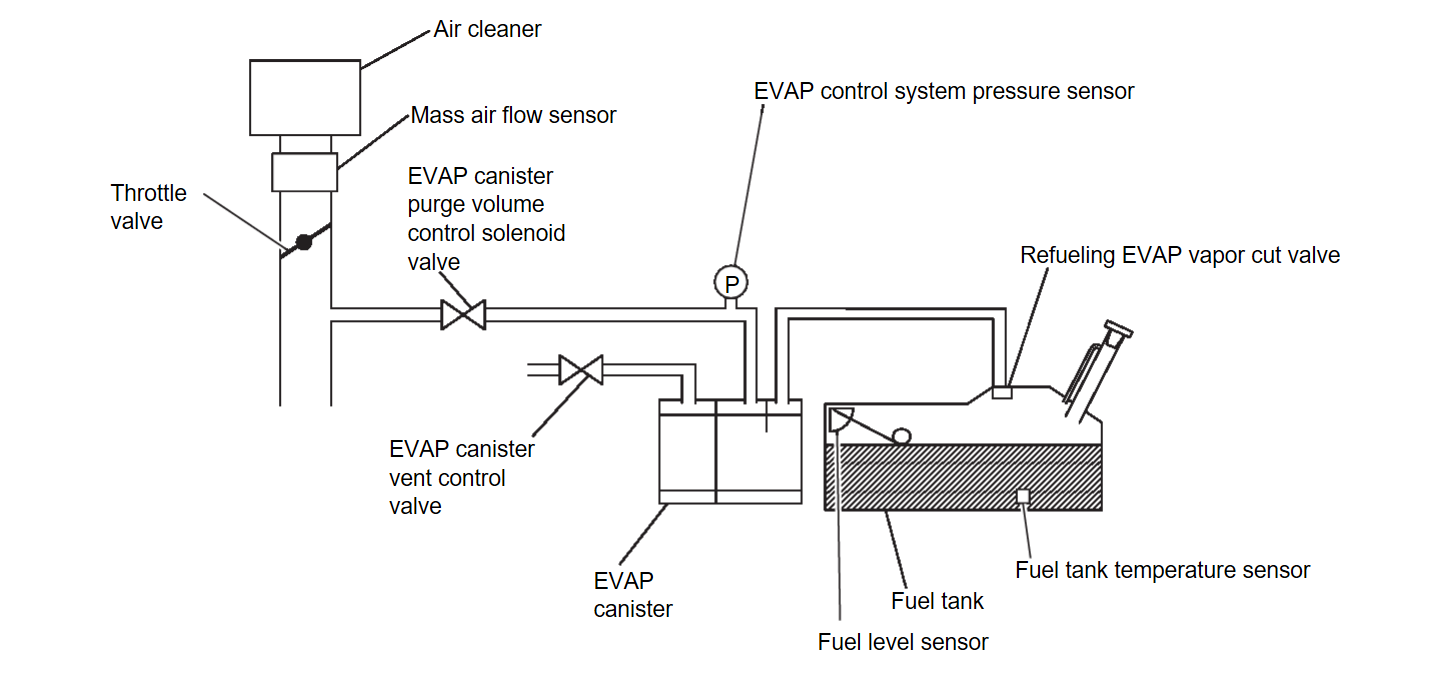DTC Description
DTC DETECTION LOGIC
This diagnosis detects leaks in the EVAP line between fuel tank and EVAP canister purge volume control solenoid valve, using the negative pressure caused by decrease of fuel temperature in the fuel tank after turning ignition switch OFF.
If ECM judges there are no leaks, the diagnosis will be OK.
| DTC | M.U.T.-III SE screen terms (Trouble diagnosis content) | DTC detection condition | ||
| P0456 | 00 | EVAP VERY SML LEAK [EVAP system leak detected (very small leak)] | Diagnosis condition | — |
| Signal (terminal) | — | |||
| Threshold |
| |||
| Diagnosis delay time | — | |||
| caution |
|
POSSIBLE CAUSE
- Incorrect fuel tank vacuum relief valve
- Incorrect fuel filler cap used
- Fuel filler cap remains open or does not close.
- Foreign matter caught in fuel filler cap.
- Leak is in line between intake manifold and EVAP canister purge volume control solenoid valve.
- Foreign matter caught in EVAP canister vent control valve.
- EVAP canister or fuel tank leaks
- EVAP purge line (pipe and rubber tube) leaks
- EVAP purge line rubber tube bent
- Loose or disconnected rubber tube
- EVAP canister vent control valve and the circuit
- EVAP canister purge volume control solenoid valve and the circuit
- Fuel tank temperature sensor
- O-ring of EVAP canister vent control valve is missing or damaged
- EVAP canister is saturated with water
- EVAP control system pressure sensor
- Refueling EVAP vapor cut valve
- ORVR system leaks
- Fuel level sensor and the circuit
- Foreign matter caught in EVAP canister purge volume control solenoid valve
FAIL-SAFE
Not applicable
DTC Confirmation Procedure
1.PRECONDITIONING
If DTC Confirmation Procedure has been previously conducted, always perform the following before conducting the next test.
- Turn ignition switch OFF and wait at least 10 seconds.
- Turn ignition switch ON.
- Turn ignition switch OFF and wait at least 10 seconds.
Do you have M.U.T.-III SE?
2.PERFORM DTC CONFIRMATION PROCEDURE-1
 WITH M.U.T.-III SE
WITH M.U.T.-III SE- Turn ignition switch ON and select “EVAP DIAG READY” in “DATA MONITOR” mode of “ENGINE” using M.U.T.-III SE.
- Start engine and wait at idle until “OFF” of “EVAP DIAG READY” changes to “ON”.
note It will take at most 2 hours until “OFF” of “EVAP DIAG READY” changes to “ON”. - Turn ignition switch OFF and wait at least 90 minutes.
note Never turn ignition switch ON during 90 minutes. - Turn ignition switch ON and select “EVAP LEAK DIAG” in “DATA MONITOR” mode of “ENGINE” using M.U.T.-III SE.
- Check that “EVAP LEAK DIAG” indication.
Which is displayed on M.U.T.-III SE?
3.PERFORM DTC CONFIRMATION PROCEDURE-2
4.PERFORM DTC CONFIRMATION PROCEDURE
 WITH GST
WITH GST- Start the engine and wait engine idle for at least 2 hours.
- Turn ignition switch OFF and wait at least 90 minutes.
note Never turn ignition switch ON during 90 minutes. - Turn ignition switch ON.
- Check 1st trip DTC.
Is 1st trip DTC detected?
 Proceed to DTC Diagnosis Procedure
Proceed to DTC Diagnosis Procedure .
. -1To check malfunction symptom before repair: Refer to Intermittent IncidentIntermittent Incident
-1To check malfunction symptom before repair: Refer to Intermittent IncidentIntermittent Incident .
. -2Confirmation after repair: INSPECTION END
-2Confirmation after repair: INSPECTION END![[Previous]](../../../buttons/fprev.png)
![[Next]](../../../buttons/fnext.png)
